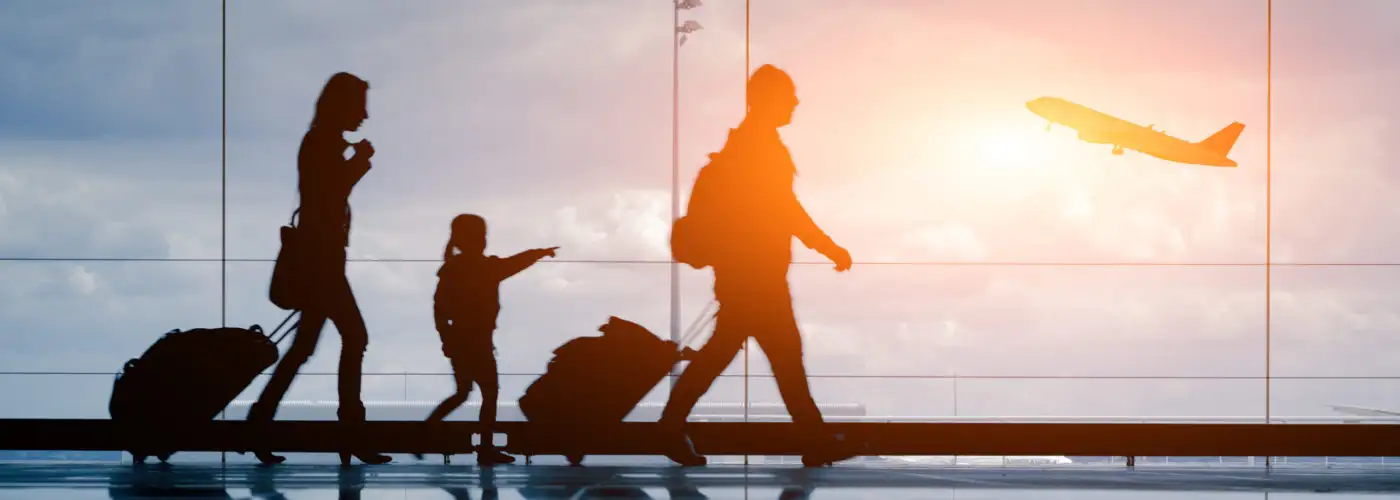Airbnbs allure. The Berkshires beckon. Cabanas call out. After the past year, you’re probably ready to jump on the nearest form of transport away. School’s out. You’ve got your vaccination card…and unvaccinated young kids.
Unless they’re in a vaccine trial, children under age 12 are not allowed to get a COVID-19 vaccine yet. Should you take the risk and travel with unvaccinated kids?
Your goal, no matter what, is to avoid spending part of your trip in an unfamiliar urgent care, ER, or worse, ICU with MIS-C, the frightening inflammatory condition that attacks some kids with COVID-19.
Here are a few main factors to consider when making the decision around traveling with unvaccinated kids:
Importance
First, there’s the importance and the type of the trip itself. Is Grandma in poor health and in need of a visit? Is a favorite cousin getting married? Are you a single parent who has an older child that needs to tour colleges? Is a parent about to be deployed far away in the fall? These would be higher-priority, more meaningful trips with time sensitivity.
Type of Trip
Is this a driving trip to national parks, with little to no indoor time? Or a trip to Paris with crowds on the planes, stopovers, the Metro, and in the museums? The former (especially with camping) is a near-ideal, low-risk COVID-19 trip. Flying, with its close quarters, mask-removing during inflight services, and crowded airports, poses a higher risk than a family driving trip and should be done only when completely unavoidable. If you must fly, think about getting pediatric N95 or KN95 masks, or double masking for travel–say, a surgical mask over a double-layer cloth mask underneath for comfort. The extra effort will help to impress upon your kids the increased risk traveling brings.
Consider Your Kids’ Abilities
Are your childrens’ mask-wearing skills and physical distancing skills good enough to make it through an entire trip? You might plan differently if your kids are too young to wear (or keep on without a fight) a mask.
However, mask-wearing alone isn’t a magic bullet. COVID-19 is a respiratory virus, which means that even two masked people can transmit it if they are close enough. Small rooms (or modes of transportation) with low ceilings and poor ventilation are high risk; large, open areas are lower risk. For the aforementioned wedding, unless the couple requires proof of vaccination or a very recent test for admission, you must assume that everyone could have active COVID-19 and act accordingly, especially at an indoor reception or in a busy hotel. If your kids can handle remaining masked other than while eating and generally keep their distance from strangers, they will run a much lower chance of getting COVID-19.
There’s another good reason to make sure your kids are diligent mask-wearers—the rise in respiratory viruses this summer. Instead of adult ICUs and ERs being full this summer, it’s pediatric ICUs, with RSV (respiratory synctitial virus), adenovirus, rhinovirus, enterovirus, and parainfluenza (a common croup culprit).
Meanwhile, parents are reporting their kids getting sick after only one unmasked outing or interaction with other kids. Any sniffle or fever on vacation is going to mean quarantining in a hotel, a trip to get a COVID-19 test, and barred admission to anything where guests are being screened for upper respiratory illness symptoms.
The Destination
Finally, what’s the vaccination and COVID-19 situation in your proposed destination? A vacation to Vermont, where over 70 percent of the population (the people you’ll encounter in grocery stores, at sights, and in shopping areas) is vaccinated, has a different risk than going to Louisiana, where less than 50 percent of the population is vaccinated.
You can look at case counts for the prior 7 days at the WHO’s website. Here, you can see, for example, that Brazil accumulated nearly 500,000 new cases in 7 days. The State Department website can tell you COVID-19 restrictions for each country; Singapore, for example, just barely reduced its mandatory quarantine to 14 from 21 days. Quarantine periods in unfamiliar places and how your kids fare in such environments and with change in general should factor into your decision-making. News organizations can also give you a picture of what vaccination rates are like in your country of interest.
You Might Also Like:
• US Issues Unusual Travel Warning for Popular Caribbean Country• 4 Common Travel Disasters and How to Prevent Them
• The Ultimate Toiletry Kit Packing List
• 6 Ways to Avoid Getting Sick After Flying
• 5 Hotel Nightmares That Could Happen to You
We hand-pick everything we recommend and select items through testing and reviews. Some products are sent to us free of charge with no incentive to offer a favorable review. We offer our unbiased opinions and do not accept compensation to review products. All items are in stock and prices are accurate at the time of publication. If you buy something through our links, we may earn a commission.
Related
Top Fares From Wichita, KS
Today's Top Travel Deals
Brought to you by ShermansTravel
Shop and Save with Country Inns...
Patricia Magaña
 Hotel & Lodging Deals
Hotel & Lodging Deals
$229 -- Chicago: Discounted Rates and...
Francesca Miele
 Hotel & Lodging Deals
$229+
Hotel & Lodging Deals
$229+
$188 -- Honolulu: Save on Oceanview...
Abigail Lamay
 Hotel & Lodging Deals
$188+
Hotel & Lodging Deals
$188+




